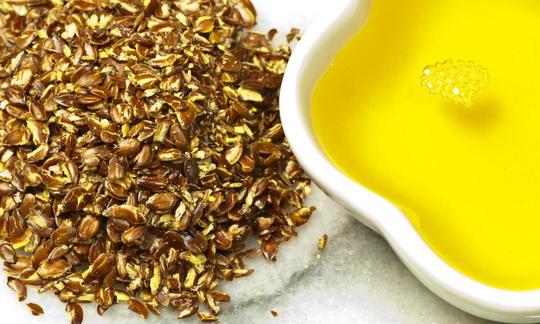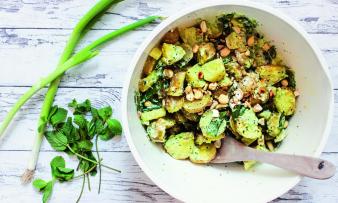Table of contents
Cold-pressed linseed oil ( linseed oil , flax oil ) is obtained from linseed, the ripe seeds of the common flax or flax plant ( Linum usitatissimum ).
Use in the kitchen:
What should linseed oil taste like? Fresh linseed oil smells spicy like hay. It tastes nutty, slightly roasted and can have a fishy note.
Linseed oil can be used to enrich muesli, herb curd and yoghurt or to prepare salad dressings and dips . Because of the high sensitivity to oxidation, it is advisable to use freshly ground or crushed linseed instead of linseed oil, see for example Erb-Müesli or Erb-Müesli plus oat flakes .
In Lusatia, Saxony and Silesia, linseed oil is traditionally used in dairy dishes such as quark with potatoes or boiled potatoes, in cucumber salad or in sour herring in cream sauce. The layer of oil on the dairy dishes prevents them from turning sour quickly, which was used in the summer. Linseed oil is also a component of many dishes in Upper Austrian cuisine. There, linseed oil is registered as a traditional food. 1
Can you fry with linseed oil? and: How hot can linseed oil get? Linseed oil is not suitable for stewing or frying. The oil consists mainly of polyunsaturated, reactive fatty acids, which change at temperatures just above 100 °C. This can lead to the formation of harmful substances such as acrylamide, polycyclic aromatic hydrocarbons (PAH) or N-nitroso compounds. Linseed oil should therefore only be used in cold cooking. Already cooked dishes can also be enriched immediately before serving. 2
We generally recommend avoiding high heat and steaming gently or preferring raw food. With a pure raw food diet, you can completely avoid the intake of harmful trans fats and Maillard molecules (more on this in this book review ).
Recipe for "cheese sauce" with potatoes and carrots:
For the vegan "cheese sauce", put 25 g of soaked cashews , 190 g of soft-boiled potatoes and 55 g of carrots , a peeled garlic clove , 3 tbsp of yeast flakes, 1 tbsp of linseed oil, 2.5 tbsp of drinking water , 1.5 tsp of lemon juice , 0.5 tsp of sea salt and 0.5 tsp of white wine vinegar in a blender and puree until smooth. If the mixture is too thick, add a little more water. Finally, season the vegan "cheese sauce" to taste and add chili powder or flakes if necessary. This "cheese sauce" is suitable, for example, as a dip for raw vegetables, for crackers or tortilla chips. You can find the full recipe HERE .
| Not only vegans or vegetarians should read this: Vegans often eat unhealthily. Avoidable nutritional mistakes . |
Shopping - where to buy?
Linseed oil is increasingly available as a controlled organic product as cooking oil, even in supermarket chains such as Coop , Migros , Spar , Aldi , Lidl , Rewe , Edeka or Hofer . Denner and Volg do not seem to have linseed oil in their range. You can buy linseed oil in health food stores, organic shops, drugstores such as Müller , Rossmann or DM , in local, traditional oil mills, online and in organic supermarkets such as Denns or Alnatura, mostly in organic quality.
Linseed oil is available in different packaging units. Many retailers offer the practical 50 ml bottle. As a local product, linseed oil is environmentally friendly because long transport routes are eliminated.
Cold-pressed linseed oil comes from mechanical and as gentle a pressing as possible without external heat. The raw material may be heat-treated before processing. 3,4
Cold-pressed oils (laws, raw food)
In Switzerland, oil is referred to as cold-pressed oil if the oilseed was not heated, the pressing temperature did not exceed 50 °C and no problematic post-treatment took place.
According to the Federal Department of Home Affairs ( FDHA ), an edible oil is considered cold-pressed (or may be described with synonyms such as (extra) virgin, unrefined, cold-pressed or natural) if it has been obtained by pressing or centrifuging from previously unheated raw materials, the temperature during pressing did not exceed 50 °C and it has not been subjected to refining, i.e. no neutralisation, no treatment with adsorbents, bleaching earth or steaming .
An oil may be described as “gently steamed” if the refining process was limited to steaming and the temperature did not exceed 130 °C . 26
In the EU and the USA, there does not appear to be a generally applicable temperature limit set by law for cold-pressed oils. For example, the guidelines for edible fats and oils of the Federal Ministry of Food and Agriculture (D) are similar to the EDI regulation, but they do not specify a permissible maximum temperature for general cold pressing - since they only apply to products whose labelling and composition are not conclusively set by law (i.e. not for olive oil, cocoa butter, milk fats, spreadable fats, for example). 27
On the other hand, both the EU directives and the amendment to the EDI regulation on foods of plant origin, mushrooms and table salt (and its amendment) provide for a special rule for the labelling of olive oils . 28,29
These are selective marketing rules in which the term raw food is not defined. "Raw food" and "raw" are therefore not state-protected terms (as is the case with the term "organic"), which leaves a lot of room for interpretation. Although it is agreed that with purely mechanical cold pressing, the pressing temperatures generally do not exceed 40 °C, one should not naively assume that cooking oils are raw food quality. There is a suspicion that the measuring method used does not indicate the temperature in the press cylinder (where the heat is highest), but only the outlet temperature in the oil hose. With water-cooled olive oil presses (so-called "water-cooled 37°" oil presses), one probably cannot even say with certainty what the exact temperature is inside the press cylinder, because the entire press cylinder is surrounded by cooling sleeves.
In addition, the pressing pressure and speed as well as the moisture content of the oilseed affect the pressing temperature. If, for example, the moisture content is too low, the temperature rises during pressing and it is difficult to stay even below the maximum limit of 50 °C. 30
Industrially produced linseed oil is obtained by hot pressing and the use of solvents. During the subsequent refining process, the undesirable accompanying substances are removed, resulting in an oil that is odorless and tasteless. 5
Storage:
Linseed oil is very sensitive to light. The polyunsaturated fatty acids oxidize after a short time and the oil begins to taste bitter and later rancid. The causes of this are atmospheric oxygen, light and moisture. Linseed oil should therefore be stored in a cool, dark place - especially after opening.
Even when stored in the refrigerator (around 4 °C), a bitter taste develops after a few days. 1 It is therefore advisable to buy linseed oil in small bottles and use it up within four weeks. 6 Or you can divide the linseed oil into small bottles with a good seal, and fill them as well as possible.
Our tip: If you don't need linseed oil for a few days, you can freeze it and thaw it in the fridge when needed. The melting point of linseed oil or flax oil is -16 to -20 degrees Celsius. Since oil does not expand when it freezes, the glass does not shatter. If you store linseed oil in a solid state, the aging process is slowed down dramatically. 6
Ingredients - nutritional value - calories:
Linseed oil has a striking fatty acid pattern: in addition to 9% saturated fatty acids, it contains almost 90% unsaturated fatty acids. 45 to 71% (USDA 53%) are polyunsaturated omega-3 fatty acids (alpha-linolenic acid, ALA) . Oleic acid makes up 17 to 23% and omega-6 fatty acids (linoleic acid, LA) make up 12 to 24% (USDA 14%). Linseed oil is considered (along with perilla oil used in Asian countries) the best food source of alpha-linolenic acid. The nutritionally very favorable ratio of LA:ALA in linseed oil is 1:4. 7,8 Just one tablespoon provides 7.3 g of omega-3 fatty acids, which covers a woman's daily requirement (2,000 kcal) several times over. 6,8 Here is the comparison with other oils: linseed oil (LA:ALA 1:4), rapeseed oil (LA:ALA 2:1), camelina oil (depending on the literature source 2 or 3:1), hemp oil (LA:ALA 4:1) or walnut oil (LA:ALA 5:1). Because of their extremely high linoleic acid content,sunflower oil , peanut oil, grape seed oil , safflower oil or corn germ oil should be avoided, as should palm fat or coconut fat , which are rich in saturated fatty acids. 8
In order to achieve a favorable ratio of omega-6 fatty acids to omega-3 fatty acids in your diet, it is better to use seeds and nuts in the long term. Oils and fats, on the other hand, should generally be consumed in moderation. Seeds (e.g. linseed , chia seeds , hemp seeds ) and nuts (e.g. walnuts ) can easily cover your needs. Some prominent doctors in the USA, especially heart specialists, are actively promoting a diet without oil.
Does linseed oil contain hydrocyanic acid? Linseed contains cyanogenic glycosides, which are converted into hydrocyanic acid through enzymatic conversion. Since the cyanogenic glycosides are water-soluble, they remain in the press cake when linseed oil is produced. Linseed oil is therefore largely free of cyanogenic glycosides and cyanide (salts of hydrocyanic acid). An Australian-New Zealand study was able to confirm this. 24,25 A health risk from cyanide in linseed oil could be ruled out in all age groups. 9,10
You can find all the ingredients, the coverage of the daily requirement and comparison values with other ingredients in our nutrient tables. In the article Nutrients explained you will get a detailed insight into the topic.
Health aspects - effects:
Why is linseed oil so healthy? No oil is actually healthy, but rather an unnatural concentrate like white sugar. A natural substitute would be linseed, because omega-3 fatty acids are basically a component of all cell membranes and ensure the elasticity of cells and vessels. They are found in high concentrations in the brain, nerve cells and the retina of the eye. Can linseed oil lower cholesterol? The messenger substances formed from the fatty acids have a positive effect on the flow properties of the blood as well as cholesterol and triglyceride levels. Long-chain omega-3 fatty acids are effective in preventing cardiovascular diseases as well as rheumatism or chronic polyarthritis, chronic inflammatory bowel diseases and neurodermatitis (in nutritional medicine, however, the intake of fish oils to prevent coronary heart disease (CHD) is controversial 11,12 ).
From the plant-based alpha-linolenic acid (health-promoting omega-3 fatty acid), the body can produce the biologically active substances eicosapentaenoic acid (EPA) and docosahexaenoic acid (DHA) , and from the linoleic acid (omega-6 fatty acid) arachidonic acid (arachidonic acid, AA). These starting substances are used to form hormone-like eicosanoids.
Is linseed oil anti-inflammatory? While eicosanoids from EPA/DHA have antithrombotic, anti-inflammatory, bronchodilator and vasodilator effects, eicosanoids from arachidonic acid have the opposite effects. 11,13
The formation of EPA/DHA and arachidonic acid is in competition with each other because the same enzymes are responsible for this. Therefore, both the ratio of omega-6 to omega-3 fatty acids and the amount actually consumed through food are crucial. The health-promoting ratio of a maximum of 5:1 (omega-6 to omega-3) is considered desirable. A typical western diet is on average around 8 to 15:1. 7,11,13
The conversion rate of alpha-linolenic acid to EPA and DHA varies between 0.3 and 8% in men and between 9 and 21% in women. A high consumption of linoleic acid reduces the conversion rate significantly. Therefore, you should consume fewer foods rich in linoleic acid. These include grape seed oil (58-78%), safflower oil (55-81%),sunflower oil , peanut oil , etc. Animal fats, meat, eggs, cheese, etc. are even worse because they directly contain high levels of inflammation-promoting arachidonic acid (AA).
Some nutritional doctors recommend getting EPA and DHA through food. 13,14
However, vegans generally show sufficient conversion of ALA into EPA and DHA when their intake of omega-6 fatty acids is low. 14 Data from the EPIC study ( European Prospective Investigation into Cancer and Nutrition ) suggest that the body probably produces more EPA and DHA from ALA when the intake of these higher homologues through food is scarce. 7 Scientists were able to show that the supply of EPA and DPA (precursor of DHA) was significantly improved by the administration of linseed oil.
Although the DHA level in the blood decreased, the inflammatory parameters were proven to decrease when two tablespoons of linseed oil were taken daily. 11 Of course, it would have been better to use linseed, but then it would not have been a study for the oil industry and therefore not financially possible. There is scientific evidence that DHA enrichment is possible through the sole intake of plant-based ALA when other polyunsaturated fatty acids, particularly omega-6 fatty acids, are low in the diet. 7
Which is the healthiest oil? If you use oil, it basically depends on the amount used, the purpose and the fatty acid composition. Above we mentioned the vegetable oils and fats that should be avoided in particular. Whole foods such as nuts, seeds, olives or avocados would be better anyway (more information on this can be found under rapeseed oil ).
Linseed oil as a superfood? As described in the next section, an excessive intake of omega-3 fatty acids is also harmful to health. What Paracelsus said about 500 years ago still applies to all foods today: All things are poisonous and nothing is without poison; only the dose makes a thing not poisonous . On the other hand, linseed and thus also linseed oil contain secondary plant substances , for example 206 mg/100g ofbeta-sitosterol according to the USDA.
Dangers - Intolerances - Side effects:
During the oxidation of oxygen-sensitive polyunsaturated fatty acids, cell-damaging metabolic products can be produced. For this reason, one should ensure that one consumes sufficient antioxidants (e.g. vitamin E or vitamin C ). 11 But we can give the all-clear: with a natural diet with lots of fruit and vegetables, we supply the body with sufficient antioxidants.
Something about DHA/EPA capsules
An excessive intake of polyunsaturated fatty acids is associated with a higher risk of the formation of lipid peroxides and can lead to LDL cholesterol oxidation (low-density lipoprotein). The Federal Institute for Risk Assessment ( BfR ) also warns of the health risks of an excessive intake of more than 700 mg DHA/EPA per day (d). If taken in excess, they can increase cholesterol levels (from 0.7 g EPA/DHA/d) and the tendency to bleed (from 1.5 g EPA/DHA/d) as well as impair the immune system, especially in older people.
Depending on the diet, the female metabolism can produce up to 1 g of long-chain omega-3 fatty acids (EPA, DHA) from one tablespoon of linseed oil (7.3 g ALA). The average conversion rate is 15%, but significantly lower in men. 11,13,15
In 2012, the EFSA ( European Food Safety Authority ) re-evaluated the health effects of long-chain omega-3 fatty acids. The EFSA considers up to 500 mg of EPA and DHA per day to be safe, but has not set an upper limit. 250 mg is considered sufficient for the prevention of cardiovascular disease and the maintenance of normal heart function. 11
Can linseed oil be harmful? The Apotheken-Umschau points out that linseed oil increases the risk of premature birth. There is scientific evidence that pregnant and breastfeeding women should consume linseed with caution, as the seeds could affect the fertility of their offspring. However, the maximum consumption of 15 g of linseed per day also seems to be well tolerated by pregnant and breastfeeding women. We cannot judge to what extent this warning applies to linseed oil. 16,17 You can read why there is a maximum consumption amount for linseed in our article Linseed (golden linseed, flax) .
Use as a medicinal plant:
Flax is the medicinal plant of the year 2005. The oil produced from it is used for pharmaceutical purposes. As a medicinal product, linseed oil is used as a dietary supplement (e.g. in the form of capsules) for eczema, menstrual problems, atherosclerosis (arteriosclerosis) and rheumatoid arthritis. 1,18
Is linseed oil good for the skin? Cosmetic products that contain linseed oil are said to regenerate and revitalize the skin. There is no evidence that the skin absorbs the polyunsaturated fatty acids. Wikipedia says that linseed oil soap with clove oil and lemongrass is said to have a stimulating and refreshing effect on the skin. 1
Occurrence - Origin:
Common flax ( Linum usitatissimum ) is an ancient cultivated form of Linum bienne , a biennial wild flax native to the Mediterranean region. This species was cultivated in Mesopotamia from 7,500 BC. Common flax probably originated in Mesopotamia or Egypt. 19 Flax grows in the temperate and subtropical regions of both hemispheres. 20
Along with barley , wheat , lentils and peas, linseed is one of the five earliest agricultural plants of the Eurasian culture in the Neolithic period (from 11,500 BC). Linseed oil, with its high content of omega-3 fatty acids, is a nutritionally important achievement of the Neolithic period. Alongside later oils from hemp and poppy, linseed is the only historical oil plant in Europe. 1
In the 20th century, the use of nutrient-rich linseed oil was widespread among the Central European population. Family-run oil mills preferred to press the regionally grown linseed into oil. The Lusatian oil mill in Hoyerswerda (D), founded in 1924, has since gained popularity under the protected name of its geographical origin "Lusatian linseed oil". Today, linseed oil is once again receiving greater attention thanks to its content of polyunsaturated fatty acids. Small-scale oil mills press local linseed into fresh linseed oil, usually in small batches. 1,21
Cultivation - Harvest:
The main cultivation area for oil flax is North America and the main cultivation country is Canada. Between 1996 and 2005, the annual, considerably fluctuating harvest quantities of flaxseed were between 517,000 and 1,082,000 tons. According to the FAO ( Food and Agriculture Organization ), the world harvest in 2006 was 2,569,793 tons. 19
In Germany, the linseed harvest from a cultivation area of 7,100 hectares (2010) is negligible. In comparison, in 1875, oil flax was cultivated on 215,000 hectares. 21
Manufacturing – Production:
Cold-pressed linseed oil is obtained by pressing the linseeds using a screw press. The linseeds are pressed through a press cylinder using a screw roller at low pressure. Cold pressing ideally achieves oil temperatures of a maximum of 40 °C. The suspended matter is removed by settling before use. 1
Since linseed oil oxidizes very quickly due to atmospheric oxygen during cold pressing, various pressing processes have been developed that exclude oxygen to prevent oxidation during the pressing process. This is done by using a protective atmosphere of pure nitrogen or carbon dioxide, which keeps the oxygen in the air away from the pressed material and the oil. These oils are of high quality because care is taken during production to ensure that neither oxygen nor light can reach the oil. 1
Animal protection - species protection - animal welfare:
Flax plants bear numerous flowers, but these only have low pollen and nectar values. This makes flax less interesting as a bee pasture. 22
General information:
Linseed oil is a vegetable cooking oil that is obtained from linseed, the ripe seeds of the flax plant. In addition to the actual oil linseed ( Linum usitatissimum = "most commonly used"), other types of linseed from the genus Linum are also used for oil production. 1
According to DIN ( German Institute for Standardization ), crude linseed oil must have certain properties in terms of sediment, acid number and phosphate acid. Crude linseed oil is the starting product for technical purposes. The purified crude oil is used for craft applications. 1.23
Camelina oil is obtained from the seeds of the camelina plant ( Camelina sativa ); it should not be confused with linseed oil. The oil is also rich in alpha-linolenic acid, at 33-41%. 15
Alternative names:
Alternative names for linseed oil are linseed oil and flax oil.
Common names in the English language are flaxseed oil, linseed oil, crude linseed oil or flax seed oil.
Keywords for use:
Variants of the technical use of (raw) linseed oil: biofuel, binding agent for wood and window putty, linoleum, decorative coatings (moonlighting, wrought iron, varnish firing, patination, burnishing), corrosion protection, balm (seafaring), wood protection, binding agent for oil paints, coatings (wood primer, linseed oil paint, linseed oil varnish), violin making, painting, semi-oil, stand oil, impregnation, primer, glaze, press residues as animal feed 1 , textiles (linen fabric, eco-fashion, fibre flax), cosmetics etc.
Literature - Sources:
Bibliography - 24 Sources
| 1. | wikipedia.org Leinöl. |
| 2. | ugb.de (Unabhängige Gesundheitsberatung) Fette und Öle: Unbeschwerter Genuss in der Vollwertküche. |
| 3. | praxistipps.focus.de Native Öle: Wie gut sind Fette? |
| 4. | bzfe.de (Bundeszentrum für Ernährung) Speisefette und Speiseöle. |
| 5. | wikipedia.org Pflanzenöle. |
| 6. | bzfe.de (Bundeszentrum für Ernährung) Ohne Flachs und Krümel. Lein als Öl- und Faserpflanze. |
| 7. | ugb.de (Unabhängige Gesundheitsberatung) Omega-3-Fettsäuen: Leinöl statt Fischöl? |
| 8. | USDA (United States Department of Agriculture): Nährstofftabellen. |
| 9. | Herzog, Katja. Hofstädter Daniela. AGES Österreichische Agentur für Gesundheit und Ernährungssicherheit GmbH. Cyanogene Glykoside in Leinsamen. Risikobewertung. PDF. |
| 10. | bzfe.de (Bundeszentrum für Ernährung) Expertenforum: Sie fragen – aid antwortet. Leinöl Blausäure. |
| 11. | ugb.de (Unabhängige Gesundheitsberatung) Mehr Omega-3-Fettsäuren ins Essen. |
| 12. | Biesalski, Hans Konrad; Grimm, Peter; Nowitzki-Grimm, Susanne. Taschenatlas Ernährung. 6. Auflage. Stuttgart; 2015. Georg Thieme Verlag. |
| 13. | Leitzmann, Müller, Michel, Brehme, Triebel, Hahn, Laube. Ernährung in Prävention und Therapie. 3. Auflage. Stuttgart; 2009. Hippokrates Verlag. |
| 14. | Kasper Heinrich. Ernährungsmedizin und Diätetik. 12. Auflage. München; 2014. Elsevier GmbH Urban & Fischer. |
| 15. | aid Infodienst (Herausgeber) Speisefette. 17. Auflage. Bonn; 2014. Druckerei Lokay e. K. Reinheim. |
| 16. | apotheken-umschau.de Heilpflanzen-Lexikon: Leinsamen. |
| 17. | Janet C. L. Tou, Jianmin Chen, Lilian U. Thompson: Flaxseed and Its Lignan Precursor, Secoisolariciresinol Diglucoside, Affect Pregnancy Outcome and Reproductive Development in Rats. In: The Journal of Nutrition. Band 128, Nr. 11, November 1998, S. 1861–1868, PMID 9808635. |
| 18. | Bown, D. Kräuter. Die grosse Enzyklopädie. Anbau und Verwendung. 2. Auflage. München; 2015. Dorling Kindersly. |
| 19. | wikipedia.org Gemeiner Lein. |
| 20. | wikipedia.org Lein. |
| 21. | airberaten.net Leinsamen: Kleine Nährstoffwunder. |
| 22. | hortipendium.de Bienenweiden. |
| 24. | Cunnane et al. High α-linolenic acid flaxseed (Linum usitatissimum): some nutritional properties in humans. British Journal of Nutrition 1993 March; 69 (2):443-453. |
| 25. | legislation.gov.au Food Standards Australia and New Zealand. |











Comments